 |
2006 Users Group Workshop and Annual Meeting highlights presentations, discussions of "The Expanding Physics of Jefferson Lab"
|
 |
SURA presents thesis and poster contest awards at Users Group Workshop and Annual Meeting
|
 |
From the Director: New contract transition complete: thank you for your focused work during bid, transition process
|
 |
JLab successfully completes federal EPA environmental compliance inspection
|
 |
Keith Baker accepts physics professorship at Yale University
|
 |
Graduate Student Association works to improve student experiences at JLab, broaden knowledge, advance organizational & leadership skills, and provide for social interaction
|
 |
JLab Milestones for May through early July 2006 (listed alphabetically)
|
 |
JLab mourns loss of colleague, visiting scientist Razmik Asaturyan
|
 |
Dr. Ray Orbach sworn in as first DOE Under Secretary for Science
|
 |
Department of Energy website provides `Easy Ways to Save Energy'
|
 |
Energy Department provides $96.4 million to low-income families for home weatherization; $4.3 million goes to Virginia low-income homes
|
2006 Users Group Workshop and Annual Meeting highlights presentations, discussions of "The Expanding Physics of Jefferson Lab" (top ^)
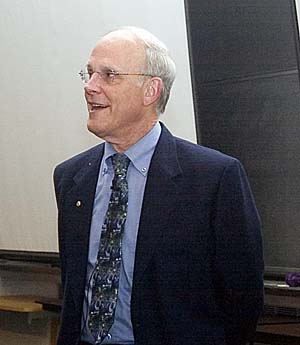
Guest speaker at this year's users meeting and workshop was Physics Nobel Laureate David Gross. On the first day of the meeting, he spoke to scientists during a special session; and that evening he gave a public talk. Both events packed the CEBAF Center auditorium.
Highlights from current nuclear physics research conducted at Jefferson Lab, ongoing work for the planned 12 GeV Upgrade to the Continuous Electron Beam Accelerator Facility (CEBAF), a guest lecture by Physics Nobel Laureate David Gross, and ongoing Nuclear Science research budget concerns brought more than 170 researchers to JLab for the 2006 Users Group Workshop and Annual Meeting. The event kicked off the morning of June 12 with Users Group Board of Directors (UGBOD) Chair Gordon Cates, University of Virginia, and JLab Director Christoph Leemann welcoming the group.
Users, members of JLab's staff and Department of Energy Site Office staff gathered at JLab's CEBAF Center auditorium June 12- 14 for a full agenda that included approximately 50 sessions devoted to ongoing or recently completed nuclear research or detector systems in JLab's three experimental halls, related nuclear research conducted at other facilities, and the theoretical developments behind, and the planned experimental research and construction-design efforts for the 12 GeV (billion electron volts) Upgrade to CEBAF. The Upgrade will allow researchers to study the strong force (confinement), nuclear structure, and the structure of protons and neutrons at an unparalleled level of precision. Scientific research sessions covered topics ranging from nuclear effects, the nucleon spin structure, form factors, hypernuclei and strangeness, to parity and related physics, transversity and orbital motion, structure functions and high-x physics, low-energy Quantum Chromodynamics (QCD) and sum rules, generalized parton distributions (GPDs) and deeply virtual Compton scattering (DVCS).
"It was a particularly nice program," Cates said. "Many of our speakers addressed topics relevant to the connections between the physics we study at JLab and the rest of the scientific community."
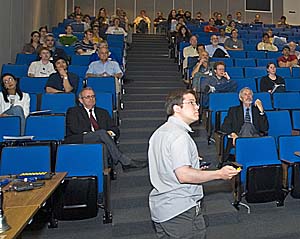
Carlos Munoz Camacho (CEA-Saclay), JLab user and winner of the 2005 SURA Thesis Prize, presented his scientific research and results during a special session on the last day of the 2006 users meeting and workshop. His paper, titled "Deeply Virtual Compton Scattering in the Hall A of JLab."
A highlight of the plenary sessions was the presentation "QCD and Strings" by special guest David Gross, one of three physicists who share the 2004 Nobel Prize in Physics for discovering and recognizing the importance of "asymptotic freedom," a property of the strong force that explains why quarks are never found roaming free from one another. Unlike the electric and weak forces, the strong force is weaker at close range; but at large distances and low energies, the strong force is too powerful for the bound quarks to escape. Their discovery of “asymptotic freedom†explained previously perplexing experimental results from particle colliders.
In other sessions, Dennis Kovar, DOE Associate Director of the Office of Science's Office of Nuclear Physics, discussed efforts underway to improve nuclear physics funding in the U.S. and what the nuclear physics community must continue doing to contend with funding shortfalls. He encouraged physicists to work ever more diligently at communicating the value of their scientific research to their respective institutions, their state and federal legislators, and the public. Further, he emphasized the importance of scientists clearly communicating to the government and the public the benefits and return on the federal funding investment into their research.
Larry Cardman, JLab's Physics Division Associate Director, spoke with the user community on how the current nuclear physics program will fold into the 12 GeV program.
Mike Dallas, JLab's new Chief Operating Officer, said he was delighted be at JLab, which he described as a "premier research lab." He discussed the Lab's recently completed transition to its new DOE management and operation contractor, Jefferson Science Associates, LLC, and explained how competition can act as a catalyst for transformation and its benefits. He discussed the extensive management background and experience level he brings to JLab. Dallas previously managed an Army research laboratory that "while it wasn't nuclear physics research, some of it was [basic] research that might not come to fruition for 10, 15 or 20 years," he noted.
"The new contract brings together SURA's academic sector strengths and CSC's private sector strengths," according to Gordon Cates. Cates described this new form of DOE contract as an "interesting and impressive concept," and explained how users concerns were voiced during the contract bid process. He emphasized the importance of working hard to make this concept work and to provide constructive feedback on "this trend that government is working very hard to develop." He noted that the Program Advisory Committee (PAC) process won't change, and the joint/bridged appointments will remain a vital part of the Lab's staff.
During the Town Meeting, Cates strongly urged all JLab users to submit their nominations for the American Physical Society Division of Nuclear Physics leadership committee, and to provide input to the upcoming NSAC (Nuclear Science Advisory Committee) long-range planning activity. He ended the Town Meeting by introducing the new Users Group Board of Directors members and thanked the Board members preparing to step down after two years of service. The web link with the new Board Members can be found at www.jlab.org/user_resources/usergroup/board/index.html. The UGBOD includes representatives for external relations, running experiments, experimental/theory liaison, PAC issues, user space issues, computing, quality of life, graduate students and Post-Doc students.
SURA presents thesis and poster contest awards at Users Group Workshop and Annual Meeting (top ^)
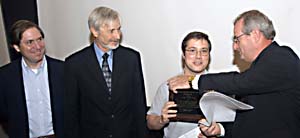
With JLab Users Group Board of Directors Chair Gordon Cates (from left) and Lab Director Christoph Leemann looking on, SURA President Jerry Draayer (far right) presents the 2005 SURA Thesis Prize to Carlos Munoz Camacho, CEA-Saclay. Draayer presented Camacho with a $1,000 check and a plaque.
On the last morning of the Users Group Workshop and Annual Meeting, Lab Director Christoph Leemann and Users Group Board of Directors Chair Gordon Cates were on hand to congratulate the Southeastern Universities Research Association (SURA) Thesis and Poster Contest winners with Jerry Draayer, SURA president, presenting the awards.
Carlos Munoz Camacho, with the Service de Physique Nucleaire, CEA-Saclay, Universite Pierre et Marie Curie (Paris, France) won the 2005 SURA Thesis Prize with his paper, titled "Deeply Virtual Compton Scattering in the Hall A of JLab." Draayer described winning the award as an â"honor and wonderful achievement" as he presented Camacho with a $1,000 check and a plaque.
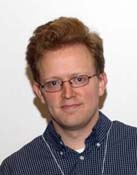
Andrew Puckett, MIT 1st place, SURA Poster Contest
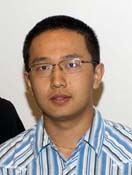
Xin Qian, Duke University 2nd place, SURA Poster Contest
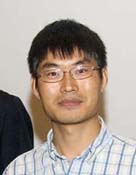
Shifeng Chen, Florida State University 3rd place, SURA Poster Contest
Five theses were submitted for the prize. Judges reviewing the submissions included Raffaella De Vita, Peter Bosted, Julie Roche, John Domingo, Bernhard Mecking and Jean Marc Laget. The theses are scored on the quality of the written dissertation, the candidate's research contribution, the work's impact on the field of nuclear physics, and the work's benefits to JLab and/or other experiments. After the awards presentation, Camacho presented his thesis research.
This was the second year for the SURA Poster Contest; and with the Users Workshop registration waived for poster contestants, a record 14 posters were entered. Taking first place in the poster contest and receiving a $1,000 check was Andrew Puckett, Ph.D. student at the Massachusetts Institute of Technology, with his poster titled "GEP-III: Experiment E04-108". Second place and a prize of $750 went to Xin Qian, Duke University, with his poster "Measurement of the Single Target-Spin Asymmetry in Semi-inclusive Pion Electroproduction on a Transversely Polarized Helium-3 Target." And third place, with a $500 prize, went to Shifeng Chen, Florida State University, for his poster titled "Measurement of Deeply Virtual Compton Scattering with a Polarized Proton Target." Judges for the poster session included Nilanga Liyanage, David Armstrong, Dennis Skopik and Jim Boyce.
The poster entries were rated on the clarity of the student's contribution to the research, clear commentary concerning the physics research and the motivation for it (in the poster), and the overall quality of the combined poster and the spoken presentation. Draayer, Leemann and Cates congratulated each of the winners as Draayer awarded the certificates and prize checks.
From the Director: New contract transition complete: thank you for your focused work during bid, transition process (top ^)
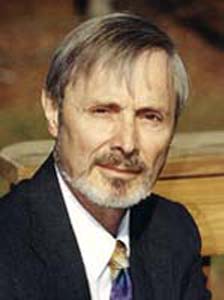
Christoph Leemann, Director
Dear Colleagues:
We completed the contract transition from SURA to Jefferson Science Associates, LLC, successfully on June 1, 2006. As President of JSA and JLab Director, I thank each of you "staff, users and subcontractors" for your focus and support in the months leading up to DOE announcing JSA as the new contractor and during this critical transition period.
I know the last several months meant more work and sometimes more stress and difficulties for many staff members. The time, effort and knowledge of many colleagues in leadership positions was critical to developing a solid and winning contract proposal and after award to make the transition to the new contract as transparent and smooth as possible. Therefore, many of you had extra work and extra responsibilities to deal with. I thank all of you who rose to the occasion and kept the Lab function effectively.
During this period, I urged that we all keep our focus on two things: worker safety and producing outstanding science. During the last six months, the Lab has continued to deliver on its world-class research program wrapping up measurements of the electric distribution in the neutron, testing theoretical predictions of the Gerasimov-Drell-Hearn integral, completing the first stage of the G0 backward-angle run, and measuring the strange quark contribution to electromagnetic form factors with unprecedented precision with the HAPPEx experiment. Enabling these experiments, Accelerator Division staff provided high quality beam "at times to all three halls simultaneously" with outstanding consistency. This is an achievement of which we can be very proud.
In the area of worker safety, however, we did not meet our goal, experiencing several reportable safety incidents. We will continue to work on these issues "understanding root causes and systematically eliminating them" until we reach the goal of having no injuries on the job, and I acknowledge that many work groups already come close to that goal. In many ways, safety is just doing a job professionally and with high quality. Often, staying safe simply means following all the rules and procedures in place. I do not want to ever see a fatality or disabling injury at JLab, and the best way to ensure that is to have engineered protection, policies and procedures, training, and disciplined behavior in place that eliminates the occurrence of even minor events. We will work together to this end and will hold all workers and all levels of management accountable.
Now, that we have completed the contract transition, we will begin to implement the key elements of the JSA proposal. In the very near future, we will complete a JLab Work Breakdown Structure, the Annual Work Plan (AWP), strengthen the Quality Assurance function within the ESH&Q division, and you will soon learn more about the previously announced Lab re-organization. Over the next 18 months, we will also fully implement a number of new business systems and their supporting software, most importantly AppliedInsight, a significant contribution by CSC. Close to completion is the new Performance Evaluation Management Plan (PEMP), following a uniform approach for all Labs within DOE's Office of Science. I will write about these developments in upcoming columns.
We have come through the contract bid process with a new contract and outstanding management and leadership teams. The FY2007 President's budget, which includes a significant increase for the DOE's Office of Science budget, is moving through the Congressional review and approval process and I am cautiously optimistic that we will see increased funding support for science in the coming fiscal year. The 12 GeV Upgrade project is moving toward CD-2 approval in approximately one year and we are producing excellent physics for the nation and world. Our Lab community has much to look forward to and with your help, we can make our promising future a reality.
I again ask for your support through your continued focus on performing your jobs effectively and safely as we go forward with new plans for the future of the Lab.
Christoph Leemann
JLab successfully completes federal EPA environmental compliance inspection (top ^)
During June, Jefferson Lab successfully completed its first-ever environmental compliance inspection by the Federal Environmental Protection Agency. The EPA team of three, with assistance from the Virginia Department of Environmental Quality, conducted its environmental compliance inspection June 26-28. During the closeout, EPA Team Leader Gerald Crutchley summarized the Lab's environmental programs as "overall, really, really good."
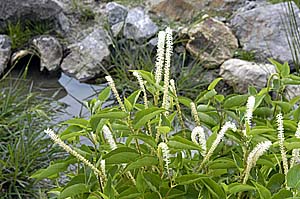
Jefferson Lab successfully completed its first-ever EPA environmental compliance inspection in June. Through the Environmental, Safety, Health and Quality Division, the Lab has a well-developed environmental protection program. Pictured here is a rain garden on JLab grounds.
The inspection was conducted by an EPA Multimedia Federal Facilities team, according to Carter Ficklen, JLab's (ESH&Q) Environmental, Safety, Health and Quality Reporting Manager. The Lab and its Department of Energy Site Office were notified on June 23 of the team's impending arrival. All environmental regulatory aspects were reviewed, including the documentation, minimization, treatment, management, transportation and disposal of hazardous and oily wastes, as well as the Lab's spill prevention program, inspections, training, and environmental permits. JLab's Environmental Management System (EMS), which was approved in December 2005, was also examined during the inspection. The team reviewed documentation, reports and plans and interviewed a number of the Lab's subject matter experts (SME).
At the closeout, Team Leader Crutchley complimented the Lab's environmental protection programs and said that he was "very impressed with the environmental knowledge of Lab staff," this even with a couple of key staff members away from the Lab during the inspection.
Further, EPA Environmental Management System Reviewer Jose Jiminez described JLab' EMS as "a good EMS, one of the best federal EMS systems" that he had seen to date.
"he Lab's exceptional performance on this review is due to the dedicated efforts of many Lab staff members who have made outstanding environmental contributions over the years," commented Craig Ferguson, Associate Director of ESH&Q. "Also, many thanks to (former) EMS Implementation team members and the current EMS Subcommittee members for all of their work over the past three years."
"My thanks to everyone at JLab for participating in the Lab's many environmental protection programs and activities," Ferguson added. "Everyone doing his or her part makes JLab a safer, healthier place to work for us, our community and the world. Please keep up the good work."
Keith Baker accepts physics professorship at Yale University (top ^)

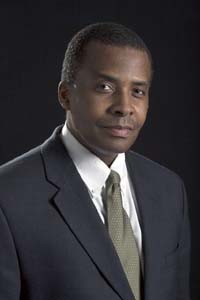 Keith Baker, joint-appointed Hampton University physics professor and JLab staff scientist has accepted an appointment at Yale University.
Keith Baker, joint-appointed Hampton University physics professor and JLab staff scientist has accepted an appointment at Yale University.
Keith Baker, a joint-appointed Hampton University (HU) physics professor and Jefferson Lab staff scientist, has accepted an appointment as a Professor of Physics at Yale University. At Yale, Baker will pursue particle physics at the energy frontier with ATLAS at the Large Hadron Collider (LHC) and continue to investigate claims of a light neutral (zero-spin) boson as a Dark Matter candidate using JLab's Free-Electron Laser.
"The opportunity to do physics at a whole new level exists at Yale," comments an excited Baker, who has been with JLab since 1989. "I've thoroughly enjoyed and benefited from my years at JLab and HU, but this opportunity was simply too good to pass up!"€
Among Baker's most notable research achievements (in collaboration with several colleagues) are: the first observation of a nuclear resonance effect in atomic electron capture, the first measurement of alpha-mu sticking in muon catalyzed fusion, the first measurement of the elementary amplitudes in the electromagnetic production of strangeness, and studies of signatures of extra dimension with the ATLAS collaboration of the Large Hadron Collider.
In one of the first physics experiments run at JLab, in Hall C in 1996, Baker led a team of researchers who used the Lab's continuous electron beam to create and explore subatomic particles called kaons. They aimed the electron beam at a hydrogen atom's proton, which is made up of three smaller particles called quarks, with the collision producing a two-quark particle called a kaon.
Baker has received several awards for his research accomplishments, including the Edward Bouchet Award from the American Physical Society for outstanding contributions to physics research, the Elmer Imes Award from the National Society of Black Physicists and the National Conference of Black Physics Students for outstanding and sustained contributions to physics research. He received a United States Presidential Appointment to the Board of the National Medal of Science and was elected to the Arkansas Black Hall of Fame, an honor he shares with individuals like poet Maya Angelou and former President William Clinton.
As a teacher and mentor, Baker received the National Award for Innovation in Teaching, Learning and Technology, was the inaugural recipient of Hampton University's E.L. Hamm Sr. Distinguished Teaching Award, and he received a citation from the Arkansas Governor for sustained mentoring of young students in science.
Baker plans to continue his research and teaching in his new position at Yale. He, his wife and their two daughters are planning a mid-August move to Connecticut.
The Large Hadron Collider (LHC) is a particle accelerator at CERN, Switzerland that will probe deeper into matter than ever before. Scheduled to begin operating in 2007, it will ultimately collide beams of protons at an energy of 14 TeV (tera-electron volts). ATLAS is a particle physics experiment slated to run in the LHC. It will explore the fundamental nature of matter and the basic forces that shape our universe.
Graduate Student Association works to improve student experiences at JLab, broaden knowledge, advance organizational & leadership skills, and provide for social interaction (top ^)
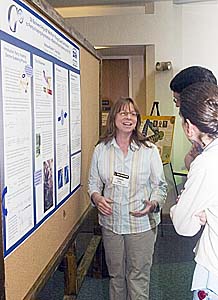
During the recent users group annual workshop and meeting, workshop attendee Colleen Ellis, University of Maryland, discusses recent JLab research with fellow students.
It's not uncommon for graduate students and post-docs pursuing a master's degree or Ph.D. in physics to focus only on conducting research and finishing a thesis. But as Bob Welsh, Executive Director of JLab's Student Affairs Office, insists, "All of us need occasional diversions when we're doing our research or our normal job." The fact that many graduate and post-doc students spend as many as 60 to 90 hours a week at the Lab is astonishing to some, but commonplace to their peers.
The reason for such extensive hours? "They want to get out of graduate school of course," remarks Welsh. The Graduate Student Association (GSA) is a student-oriented organization that provides time away from the academic demands that come with graduate-program work based at JLab and many students, including Sarah Phillips, welcome the distraction. Sarah Phillips is the current president of GSA who, along with other officers, work to organize activities for graduate and post-doc members of the Lab community.
One main goal of GSA is to help integrate the students into the community, both at the Lab and in the area as a whole. Movie nights, picnics, and concerts are just a few of the organized social events sponsored by GSA. The organization also provides recreational venues such as the sand volleyball court put in several years ago, and a soon-to-be re-established graduate student meeting room "to foster interaction and relaxation among graduate students."
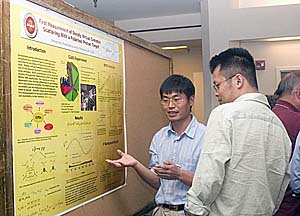
Shifeng Chen, Florida State University and third-place poster contest winner, talks with fellow researchers about his work at JLab.
GSA also promotes learning beyond individual students' respective research projects. One program that has proven successful throughout the year is the pizza luncheons hosted by GSA. At the luncheons, students are encouraged to give talks on their research. Such an opportunity provides a friendly, low-pressure environment in which students have the chance to practice speaking in front of an audience. The students who attend the program are also given a chance to learn about their colleagues' and friends' work at the Lab. All too often graduate students are focused only on their individual projects, and as a result, have little knowledge of other experiments going on around them. "It's amazing to me how many of the other experiments I know hardly anything about," laughs Phillips. "It gives us a chance to learn from each other."
Also organized by GSA, with help from Bob Welsh, is the summer lecture series, which includes a variety of subjects: advances in nuclear physics research, detector technologies, data acquisition and data analysis software. The lectures provide an opportunity for new graduate students and summer interns to be introduced to a broad range of research topics. Students familiar with the subject are encouraged to ask questions and learn new things as well. Additional offerings include day trips such as the very successful trip to the American Physical Society (APS) meeting in Baltimore this past March. About twelve GSA members attended the meeting which focused on job recruitment and education about recruitment, a concern of nearly every graduate student. The meeting proved tangibly successful for three students who were interviewed on the spot while talking to recruiters. Exposure to an APS meeting allows graduate students to get a sense of the options available to them after completing a graduate program. Both Welsh and Phillips hope that future members of GSA will actively participate in events like the APS meeting on a regular basis.
When asked what he would like to see GSA do in the future, Welsh responded with a light-hearted suggestion for the students to "build a swimming pool, a tennis court, and whatever else space and funds will permit." Realistically though, he would like to see the students continue what the current group has started. "It would be great to organize occasional trips to the beach, or trips to Charlottesville or Williamsburg, but also be certain that such things will satisfy a wide audience."
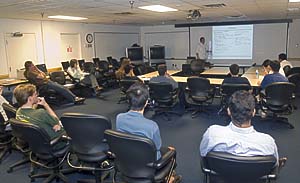
Graduate students attend one of the many research seminars that allow them to broaden their knowledge about a range of physics research and related topics
Graduate students, JLab enjoy mutually beneficial relationship
Having a number of graduate students and post-doctoral candidates at JLab serves both the students and the Lab, and provides benefits to the larger scientific community. Senior scientists, Lab mentors, and others at JLab provide students with a working knowledge of the research environment and collaborative skills that will benefit them throughout their careers.
Graduate students substantively contribute to the Lab's research effort and are a valued part of the workforce. "The experience they gain from the Lab [is taken] to other places, which increases [Jefferson Lab's] presence in the nation and even worldwide," explains Phillips "¦their performance is evaluated and it reflects well upon the Lab."
Welsh speaks favorably of the graduate students currently at the Lab. "They're a very good group. I think the students this year are working hard; I am impressed with their intelligence, their knowledge, and their likelihood to be successful in the future. Would I change anything? I don't think so."
As a graduate student, president of GSA, and participant in the 2005 Quantum Diaries project, Sarah Phillips' name is recognizable throughout the Lab. Phillips, a member of GSA since early in her graduate career, recalls thinking "students should do more, they should be more visible." As president, she has worked to make that happen. Her involvement in making GSA an organization worthy of graduate students' valuable time has proven to be a worthy cause. And although organizing events and getting others involved in the activities may take up much of her free time, she appreciates the improvement of her organizational skills - skills that will certainly prove useful in Phillips' future endeavors.
Welsh has had the opportunity to work with Phillips in a collaborative effort to further the presence of GSA at Jefferson Lab. He remarks that Phillips is attentive, efficient, and has been an excellent president. "She's done very well, and when she leaves we'll have to work very hard to find a replacement."
When asked if GSA has helped improve the quality of graduate student life, Phillips responds, "I think GSA really does make things easier, especially when you first come, and even afterwards with the networking, and of course," Phillips adds, "every graduate student appreciates free food."
GSA benefits students in many ways and is appreciated by many throughout the Lab. With its role in providing support in many facets of graduate student life, it is important that GSA stay healthy and strong in the coming years.
JLab Milestones for May through early July 2006 (listed alphabetically) (top ^)
Hello
Jeffrey Campbell, Assembly Technician, Accelerator Division
Alexandre Camsonne, Hall A Post Doctoral Associate, Physics Division
Gary Cheng, Design Engineer, Accelerator Division
Mike Dallas, JLab Chief Operating Officer, Directorate
Alex Dzierba, Distinguished SURA/JLab Fellow, Directorate
Treva Ferguson, Human Resources Assistant, Administration Division
Byron Golden, Chemistry Room Technician, Accelerator Division
James Gordon, Assembly Technician, Accelerator Division
Joanna Griffin, Multimedia Creative Specialist, Physics Division
Christopher Jenkins, Accelerator Operator, Accelerator Division
Andrew Kenyon, Hall C Mechanical Tech/Asst Installation Coordinator
Bruce Lenzer, Manager of Quality Assurance and Continuous Improvement
Environmental, Health, Safety & Quality Division
Matthew Lumanog, Mechanical/Vacuum Technician, Physics Division
Joseph Meyers, Vacuum Technician, Accelerator Division
Leonard Page, Assembly Technician, Accelerator Division
Linda Wierenga, Project Controls Manager, Directorate
Goodbye
Kenneth Crider, Student Intern, Physics Division
Roger Housman, Accelerator Operator, Accelerator Division
Eduard Pozdeyev, Staff Scientist, Accelerator Division
Richard Schwartz, Precision Survey Technologist, Accelerator Division
Chad West, PC Systems Administrator, Accelerator Division
Posted JLab Career Opportunities
There are currently a number of full time, temporary and student job positions listed on the JLab Career Opportunities webpage at http://jlab.recruitmax.com/candidate/jobs.cfm. The positions include a range of activities in the Physics and Accelerator Divisions as well as support and administration.
JLab mourns loss of colleague, visiting scientist Razmik Asaturyan (top ^)
Jefferson Lab's physics community suffered the loss of one of its visiting scientists and a long-time colleague: Razmik Asaturyan of the Yerevan Physics Institute. On the evening of June 15, Razmik passed away suddenly from a massive heart attack. A web In Memoriam remembering Razmik is located at www.jlab.org/news/releases/2006/asaturyan.html. He had been affiliated with JLab for more than a decade and had been a JLab visiting scientist since March 1999.
Hamlet Mkrtchyan, long-time friend of Razmik's and fellow Yerevan Physics Institute colleague and JLab visiting scientist returned to Yerevan, Armenia July 4, to be with Razmik's family. After final arrangements for Razmik, Hamlet, also a JLab visiting scientist, will return to JLab to complete his research program.
Dr. Ray Orbach sworn in as first DOE Under Secretary for Science (top ^)
Energy Secretary Samuel W. Bodman recently administered the Oath of Office to Dr. Raymond L. Orbach to be the Department of Energy's first Under Secretary for Science. Dr. Orbach was unanimously confirmed by the United States Senate on May 26, 2006 and began his duties June 1. President Bush nominated Dr. Orbach for the new position, created by the Energy Policy Act of 2005, in December 2005. Dr. Orbach will continue to serve as the Director of the DOE Office of Science, a position he has held since March 2002.
Dr. Orbach is a condensed matter physicist and former Chancellor of the University of California - Riverside.
Secretary Bodman issued the following statement after the administering the Oath of Office:
"Today marks an important occasion not only for my good friend Ray Orbach, but also for this department, as we elevate our science mission. As the primary supporter of physical science research in the country and home to ten national laboratories, the Department of Energy's Office of Science provides the nation and the world untold promise for discovery."
"As Under Secretary for Science, Ray will be tasked with the department's implementation of President Bush's bold new initiative, the American Competitiveness Initiative. The American Competitiveness Initiative will help us expand the United States' leadership in math and science and will allow us to continue to grow our nation's economy. I congratulate Ray on his swearing-in and look forward to his continued service to the department and to the country."
Department of Energy website provides "Easy Ways to Save Energy" (top ^)
Early this year, President Bush has called on all Americans to conserve energy and be more energy efficient due to increasing energy demands and the lingering effects of energy infrastructure damage from Hurricanes Katrina and Rita.
Energy efficiency and conservation are key components of the Department of Energy's mission. In response to President Bush's request, Secretary of Energy Samuel Bodman launched a comprehensive, national campaign to educate American families, businesses and government agencies about "Easy Ways to Save Energy" that will help them save money, too.
For Consumers:
-- Energy $avers Guide: This informative guide outlines easy ways to be more energy efficient and save money; it is available through www.energysavers.gov. The guide is also available in Spanish.
For American Business:
-- Energy Saving Teams: To help improve the efficiency of 200 of America's most energy-intensive factories by 10 percent, DOE has sent teams of energy efficiency experts to these facilities. Through this effort, DOE hopes to create momentum to significantly improve energy practices throughout U.S. industries.
For Government Agencies:
-- Energy Saving Teams: In response to President Bush's call for federal agencies to save energy, Secretary Bodman has directed teams of qualified energy experts to deploy to federal facilities to identify quick and easy ways to save energy. The federal government is the largest consumer of energy in the United States.
Visit the Energy Savers website today: www.energysavers.gov, or this related site to learn more about conserving energy, visit: http://energy.gov/energyefficiency/index.htm
Energy Department provides $96.4 million to low-income families for home weatherization; $4.3 million goes to Virginia low-income homes (top ^)
On July 6, Department of Energy (DOE) Secretary Samuel W. Bodman announced $96.4 million in weatherization program grants to 19 states to make energy efficiency improvements in homes of low-income families. Low-income Virginia homes will receive $4,344,862. Weatherization can reduce an average home's energy costs by $358 annually. Total Fiscal Year 2006 funding for this program is $243 million and will provide weatherization to approximately 96,560 homes.
"Weatherizing your home is a valuable way to save energy and money," Secretary Bodman said. "The Department of Energy's weatherization program will help nearly 97,000 families make their homes more energy efficient."
For every dollar spent, weatherization returns $1.53 in energy savings over the life of the measures. DOE's weatherization program performs energy audits to identify the most cost-effective measures for each home, which typically includes adding insulation, reducing air infiltration, servicing heating and cooling systems, and providing health and safety diagnostic services. Other benefits of weatherization include increased housing affordability, increased property values, job creation, lower owner and renter turnover and reduced fire risks. In 2005, DOE helped weatherize more than 92,000 homes.
On average, Americans spend 3.5 percent of their income on paying energy bills, but for lower-income households the costs average 14 percent. These costs can include anything from heating and cooling their homes to running the lights, computers and other appliances that need electricity.
DOE's weatherization program grants are distributed by state energy offices through more than 900 local agencies. Every state, the District of Columbia, the Navajo Nation and the Inter-Tribal Council of Arizona will receive weatherization grants this year. Awards announced today are for the 19 states that begin their weatherization year in the summer. For more information, visit: https://energy.gov/eere/wipo/weatherization-and-intergovernmental-programs-office

